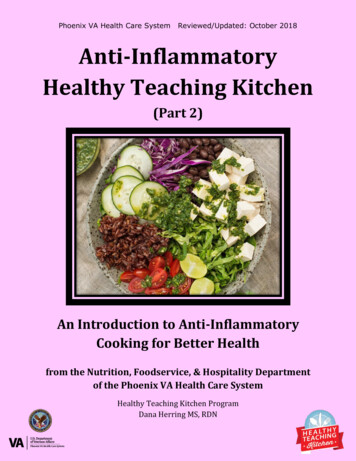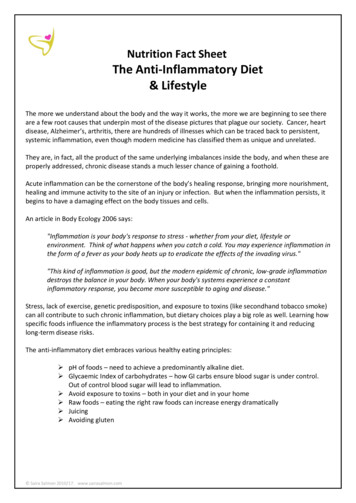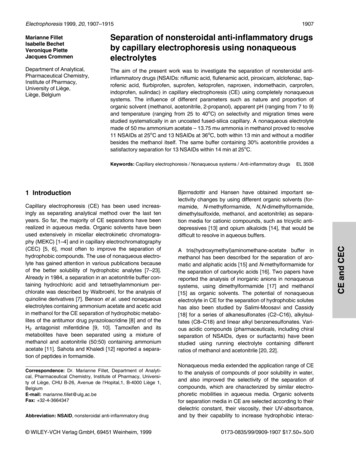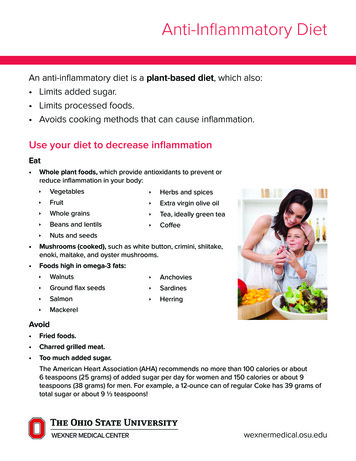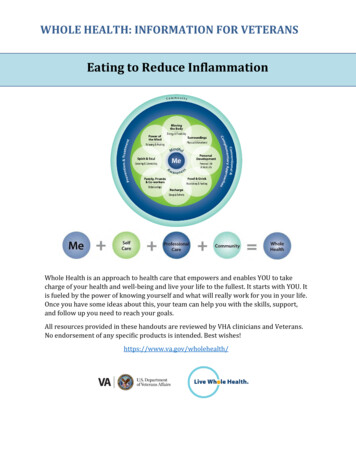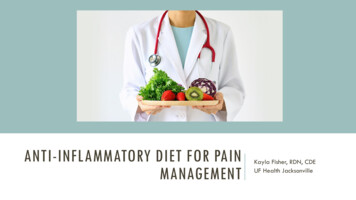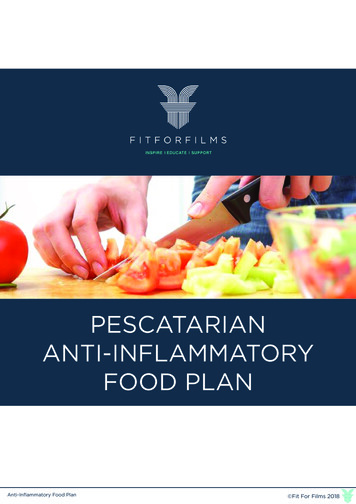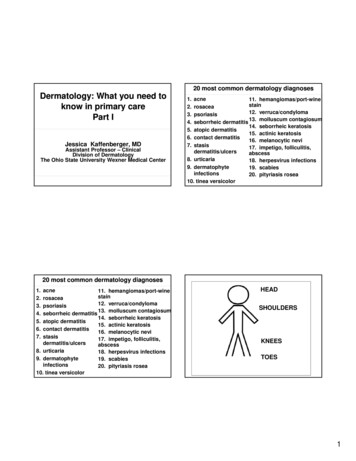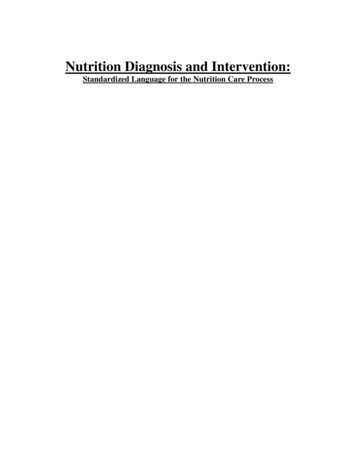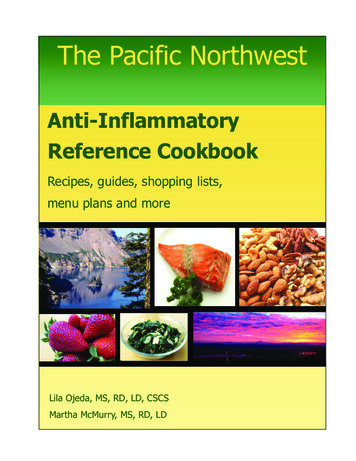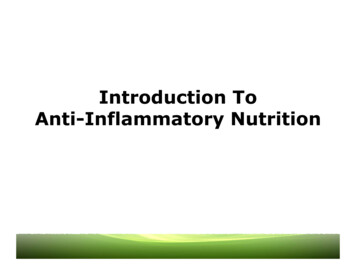
Transcription
Introduction ToAnti-Inflammatory Nutrition
Why Do We Gain Weight,Get Sick,and Age Faster?
Chronic Diseases AssociatedWith Excess Inflammation ObesityMetabolic SyndromeType 2 DiabetesHeart DiseaseCancerNeurological– Alzheimer’s, Depression, ADHD, Parkinson’s Auto-immune– Type 1 Diabetes, RA, Multiple Sclerosis Asthma Allergies Other inflammatory conditions (“itis”)
What Is Inflammation? Ancient Greeks– Internal Fire Ancient Romans– Heat– Pain– Swelling– Redness
What Is Inflammation? Complex orchestration of proinflammatory and anti-inflammatoryevents Usually associated with pain Mediated by eicosanoids Treated by drugs that alter eicosanoids––––AspirinNSAID’sCOX-2 inhibitorsSteroids
But You Need A Zone Too little of an inflammatoryresponse– Sitting target for microbes– Injuries never heal Too much of an inflammatoryresponse– The body attacks itself
Events That Turn OnInflammatory Responses Microbial invasion Injuries Diet
Overview OfAnti-Inflammatory Nutrition
The Science Of The Zone Improved hormonal control Resolution of inflammation Control of gene expression
Unique Roles For EachDietary Intervention Zone Diet– Reduction of the initiation of inflammation Omega-3 Fatty Acids– Acceleration of the resolution ofinflammation Polyphenols– Slowing of the aging process
Benefits Of Being In The Zone Reduce the likelihood ofchronic disease Slow the rate of aging Defines the clinical markers ofwellness
Clinical Markers That DefineThe Zone AA/EPA ratio– Marker of inflammation– Maintain between 1.5 and 3 TG/HDL ratio– Marker of insulin resistance– 1 (mg/dl) or 0.4 (mmol/l) HbA1C– Marker of long-term glycemic control– 5%
Our Two Immune Systems Innate (Strongly affected by the diet)– Primitive– Early response– Based on pattern recognition Adaptive (Weakly affected by thediet)– More advanced– Slowly responding– Based on memory
Innate Immune SystemMade SimpleToll‐Like Receptors (TLR) andAGE Receptors (RAGE)AAPPARγNF‐κBDNACytokine ReceptorsInflammatoryEnzymes (COX‐2)And Cytokines(IL‐1, IL‐6, TNF)
Dietary Controls onNF-κB ActivityOmega‐6 FattyAcids, SaturatedFatty Acids, ExcessCarbs ,and ExcessCaloriesZone Diet, Omega‐3Fatty Acids, andPolyphenols
Phases Of InflammationInitiating EventPro-inflammatory Initiation ResponseCellular DestructionAnti-Inflammatory Resolution ResponseCellular Rejuvenation
What Is CellularInflammation? Mismatch between the initiationand resolution of inflammation Chronic activation of innateimmune system Inflammation below theperception of pain
What Causes CellularInflammation?
The Perfect Nutritional Storm Increased Omega-6 Consumption Increased Refined CarbohydrateConsumption Decreased Omega-3 Consumption Decreased Polyphenol Consumption
How It HappensOmega‐6 Fatty AcidsActivated by InsulinInhibited by Omega‐3 FatsArachidonic AcidCellularInflammation
Three Stages Of DiseaseWellnessCellular InflammationChronic Disease
The Best WayTo Reach the Zone IsThrough The AntiInflammatoryZone Diet
Anti-InflammatorySupplements For TheAnti-InflammatoryZone Diet:Fish Oil and Polyphenols
Omega-3 Fatty Acids:Putting Our the Inflammatory Fire
Clinical Benefits OfHigh-Dose Fish Oil Heart DiseaseCancerDepressionAttention Deficit DisorderMultiple SclerosisBrain TraumaAlzheimer’sChronic PainOsteoporosisSkin DisordersFertilityFat Loss
Polyphenols:The Color of Anti-InflammationNutrition
Mechanisms Of Action Anti-oxidants Anti-inflammatory Anti-aging
A New Powerful Message Diet can turn on inflammatory genes Diet can turn off inflammatory genes
Treating Nutrition AsGene TherapyPolyphenolsOmega‐3 Fatty AcidsZone DietINFLAMMATORY GENES
Why Anti-InflammatoryNutrition Is mer’s
The Zone Diet
Beginnings OfThe Zone Diet Epidemiological studies of GreenlandEskimos (mid-1970s)– Little heart disease, cancer, depression,multiple sclerosis, etc.– Diet rich in omega-3 fatty acids 1982 Nobel Prize in Medicine– Role of eicosanoids in inflammation
Food As A DrugFoodMacronutrients(Carbohydrates, Proteins, Fat)Hormonal Response(Insulin, Glucagon, Eicosanoids)
InsulinEicosanoidsStorage HormoneMaster HormoneGlucagonMobilization Hormone
Eicosanoids Are ControlledBy Dietary Fat And InsulinDietary FatEssential Fatty AcidsGlucagonInsulin“Good” Eicosanoids“Bad”Eicosanoids
The Zone Diet is Based Upon onThe Balance of the Protein-toGlycemic LoadProtein‐to‐Glycemic Load RatioZoneKetogenicDietsHigh‐Carbohydrate DietsExcess Dietary GlucoseInsulin BalanceDeficient Dietary GlucoseFat AccumulationLoss of Inflammatory FatCortisol Increase
How We Get Fat
Why Not Eat Less,Exercise More? Eating less increases biologicaldefense mechanisms that increaseshunger Exercising more increases hunger
Why Are We Fatter?
Dietary “Answers” InThe Early 1990s Fat makes you fat– If no fat touches your lips, no fat reachesyour hips– Can eat more food, and not gain weight– Ornish diet (very-low fat diet) Carbs makes you fat– Replace carbs with even more fat– Can eat more food and not gain weight– Atkins diet (ketogenic diet)
What Is Metabolism? Conversion of dietary calories intochemical energy (ATP) Fat is high-octane fuel for ATPproduction The Fat Trap– Excess dietary calories get trapped inyour fat cells and can’t get out to beconverted into ATP
What Causes A Fat Trap?DietInflammationInsulin ResistanceFat Trap
A Third Choice Appears In1995 Inflammation makes you fat– Blood, brain, and the gut– Have to reduce calories, but withouthunger or fatigue– Zone Diet
Zone DietRecommendations (1995) 40% low-glycemic load carbs 30% low-fat protein 30% monounsaturated fat, but low inomega-6 and saturated fats 1,200 to 1,500 calories per day
Dietary Guidelines From The JoslinDiabetes Research Center At Harvard(2007) 40% low glycemic load carbs 20-30% low-fat protein 30-40% monounsaturated fat 1,200 to 1,500 calories per day
Per Cent Calories On A 40-3030 Dietary Balance Can BeDeceivingMacronutrient1,200 calories/day1,500 calories/dayCarbohydrate120 g/day150 g/dayProtein90 g/day112 g/dayFat40 g/day50 g/day
What 1,200 Calories Per DayRepresents On The Zone Diet Carbohydrates (120 grams)– 8 servings (500 g or 4 cups) of cooked vegetables– 2 servings (200 g or 1 cup) of fresh fruit– 1 serving each of lentils (1/2 cup) and oatmeal (1/2cup)– Provides 40 grams of total fiber Protein (90 grams)– Low-fat protein sources Fat (40 grams)– 2 tablespoons of extra virgin olive oil
Zone Diet and HormonalBalance
Zone Diet Induces RapidChanges in Hormonal ResponsesPlasma Glucagon (change)Serum Insulin (change)160020ng / Lpmol / L1200800100400‐100‐20012345Time (hr)012345Time (hr)High Carbohydrate, High Glycemic Load MealHigh Carbohydrate, Lower Glycemic Load MealZone MealLudwig et al. Pediatrics 103:e26 (1999)
Zone Diet and Reductionof Inflammation
CRP Reduction (%)The Zone Diet ReducesCellular Inflammation0-10-20-30-40-50USDAZonePereira et al. JAMA 292: 2482 (2004)
The Zonevs.Ketogenic Diets
Weight LossJohnston et al AJCN 83:1055 (2006)
Fat LossJohnston et al AJCN 83:1055 (2006)
EnergyJohnston et al AJCN 83:1055 (2006)
Ketogenic Diets IncreaseCellular Inflammation4030AA/EPARatio 20Start6 Weeks100High-ProteinZoneJohnston et al AJCN 83: 1055 (2006)
Metabolic Changes On AKetogenic Diet 18% increase in cortisol levels 12% decrease in T3 levelsEbbeling et al. JAMA 307:267 (2012)
Key Points Of The Zone Diet Calories do count You need adequate protein Balance your plate to balance yourhormones Reduce omega-6 and saturated fat Consume colorful carbs Fermentable fiber is important
Reducing InsulinResistance Is The KeyBenefit Of TheZone Diet
What Is Insulin Resistance? Inability to transit insulin signal tointerior of the cell Hormonal communication is garbled Caused by increased inflammation Insulin is the central point formetabolism
Insulin Resistance IsHighly Organ Dependent
Hypothalamus Balances of energy intake andexpenditure– Satiety signals from gut matched tohormonal signals (leptin and insulin) fromthe blood Sensitive to excess calories andsaturated fats– ER stress and inflammation
Hypothalamic InflammationIs Rapid Within 24 hours of HFD Precedes any weight gain Fatty acid sensors– Palmitic acid and TLR-4 receptors Pro-inflammatory– Omega-3 and oleic acids Anti-inflammatory
Liver Can start earlier than adipose tissue– 3 days after HFD– Connection to hypothalamus via vagusnerve Increase in cholesterol levels Development of fatty liver– 25% of all Americans– 90% of type 2 diabetics
Adipose Tissue Expansion of existing fat cells Hypoxia of expanded fat cells Healthy fat cells turning sick andthen dying creating moreinflammation
Muscle Primary site for glucose uptake Inflammatory cytokines from adiposetissue and liver disrupt glucoseuptake
Zone Diet:An Anti-Inflammatory DietKey Aspects: Based on the glycemic load Balance of protein, carbohydrates, and fatWhat’s Driving Physician Interest: Diet without hunger and fatigue Flexibility Moderate approachImplications: Long-term compliance Medically validated
How Difficult Is ToFollow The Zone Diet?
Start With:Low‐FatProtein
Balance With:ColorfulCarbohydratesLow‐FatProtein
Finally Add Fat!Good ChoicesExtremely BadChoices Low in Omega‐6 andSaturated Fats High in Omega‐6 Fats
Grains and Starches(Use in Moderation)Monounsaturated FatLow‐fat ProteinFruitsVegetablesZone Food Pyramid
The Zone Diet Is A BlueprintFor Hormonal Balance,Not A Philosophy Vegan Zone– No animal protein, no dairy or egg protein Lacto-ovo Vegetarian Zone– No animal protein Paleo Zone– No legumes, no dairy protein Omnivore Zone– No restrictions on protein sources
The Zone Diet Is The EvolutionOf The Mediterranean Diet It’s Mediterranean ingredientswith the Zone blueprint forhormonal balance The more white you put onthe plate, the moreinflammation you create
Effect Of Diet On NF-κBActivity In Humans High glycemic load diet increasesNF-κB activityDickinson et al AJCN 87:1188 (2008)
The Best Way To ReduceCellular Inflammation Take omega-6 fats out of the diet– Reduce raw materials needed to producearachidonic acid Reduce the use of high-glycemic carbs– Lower insulin making it more difficult toproduce arachidonic acid from omega-6 fattyacids
What Can You Expect? 2-3 Days – Lack of hunger– Better mental focus3-4 Days– Surge of physical energy7 Days– Clothes are fitting better14 Days– Better handling of stress30 Days– Greatly improved blood chemistry
Here’s The Problem Omega-6 fatty acids are the mostinexpensive calories in the world Refined carbohydrates are thefoundation of processed foods It’s easier to change your religionthan to change your diet
An Alternative Way To ReduceCellular Inflammation:Anti-Inflammatory Supplements
The Zone Diet Epidemiological studies of Greenland Eskimos (mid-1970s) – Little heart disease, cancer, depression, multiple sclerosis, etc. – Diet rich in omega-3 fatty acids 1982 Nobel Prize in Medici

